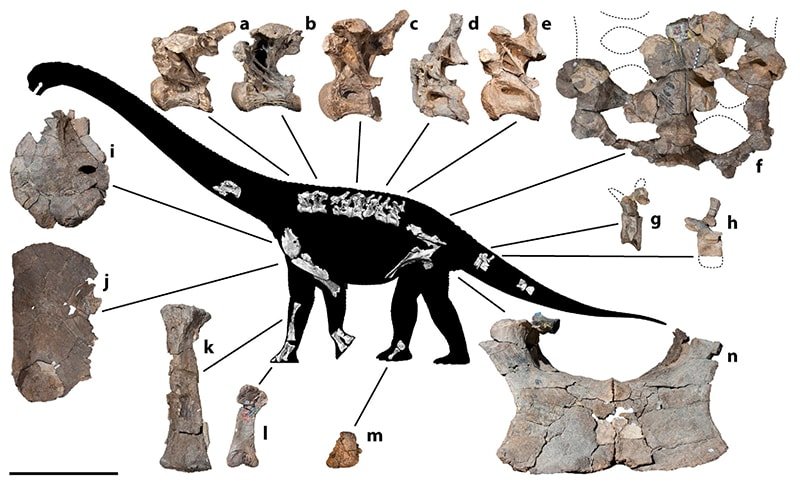Huge new dinosaur hints at when sauropods arrived Down Under

John Pickrell
John Pickrell

A team of palaeontologists in Queensland today describe a completely new species of titanosaur sauropod, a specimen they first excavated in 2005.
From the same region near Winton, in the arid west of the state, they also report the first-known sauropod skull fragments from Australia, which they believe belonged to an already known species, Diamantinasaurus.
The scientists, led by Dr Stephen Poropat of the Australian Age of Dinosaurs Museum (AAOD), studied the relationship of both Diamantinasaurus and the new species Savannasaurus to similar dinosaurs from South America, and have made the first estimate of when titanosaurs migrated across the supercontinent of Gondwana to Australia.
David Elliot, grazier and co-founder of the AAOD, stumbled across the first bone fragments of Savannasaurus elliotorum a decade ago while mustering sheep.
“I was nearly home with the mob —only about a kilometre from the yards — when I spotted a small pile of fossil bone fragments on the ground,” he says. “I was particularly excited at the time as there were two pieces of a relatively small limb bone and I was hoping it might be a meat-eating theropod dinosaur.”
Fortuitous fossil discovery
Later that day David and his wife Judy were looking over the fossils at home and found that two pieces fitted together, revealing a complete toe bone from a herbivorous sauropod. A dig later that year, involving the AAOD and scientists from the Queensland Museum in Brisbane, resulted in the collection of 17 pallets’ worth of bones that were encased in hard siltstone concretions.
A decade of careful preparation work and study finally revealed a new species of dinosaur, one represented by one of the most complete sauropod skeletons yet found in Australia. The scientists report their find today in the journal Scientific Reports.
The fossil which includes parts of the backbone, legs, pelvis and tail reveals an unusually rotund, medium-sized sauropod that would have weighed up to 20 tonnes and been 12-15m long – about half the length of a basketball court.
“Unfortunately, we do not have teeth or complete skulls for either Diamantinasaurus or Savannasaurus. However, because they were living in the same place at the same time, we suspect that they preferred different foods or slightly different habitats,” Stephen told Australian Geographic. “The bigger belly of Savannasaurus might have accommodated a larger gut, allowing it to process tougher or less nutritious vegetation.”

Dinosaur skull fragments
As they report in the same paper, the scientists did discover a new fossil including the braincase (partial skull) of a Diamantinasaurus, which they believe was a close relative of the new species. Both animals lived on the Australian part of Gondwana around 95 million years ago during the Late Cretaceous period. Diamantinasaurus would have been more slender than Savannasaurus, but slightly larger, at an estimated 23 tonnes in weight and 15-16m in length.
“This new Diamantinasaurus specimen has helped to fill several gaps in our knowledge of this dinosaur’s skeletal anatomy,” Stephen says. “The braincase in particular has allowed us to refine Diamantinasaurus‘ position on the sauropod family tree.”
Working alongside British sauropod experts Dr Philip Mannion and Professor Paul Upchurch, Stephen was able to study how these Australian dinosaurs were related to sauropods from other parts of the world.
“Both…belong to a group of sauropods called titanosaurs. This group of sauropods includes the largest land-living animals of all time,” says Phillip, who is based at Imperial College in London. “Savannasaurus and the new Diamantinasaurus specimen have helped us to demonstrate that titanosaurs were living worldwide by 100 million years ago.”
The palaeontologists noted that the Australian dinosaurs were similar to kinds of titanosaur common in South America 125 million years ago during the Early Cretaceous. They hypothesise that titanosaurs evolved in South America, but were unable to cross cold, high-latitude parts of the supercontinent until a warm spell around 105 million years ago.
Cool customers of the Cretaceous
“Australia and South America were connected to Antarctica throughout much of the Cretaceous,” says Paul. “We suspect that the ancestor of Savannasaurus was from South America, but that it could not and did not enter Australia until approximately 105 million years ago. At this time global average temperatures increased allowing sauropods to traverse landmasses at polar latitudes.”
These more primitive sauropods then persisted in an isolated Australia while other kinds of titanosaur came to dominate the environments of South America in the Late Cretaceous.
Dr Phil Bell, a palaeontologist at the University of New England in Armidale, NSW, agrees that there’s little doubt that Australian and South American dinosaurs share close ties. “A warm spell during the Albian [105 million years ago] would have permitted warm-weather loving titanosaurs into Australia via Antarctica during this time,” he says.
“Australia has long been a black hole in dinosaur palaeontology – it doesn’t willingly let go of its secrets,” adds Phil, who was not involved in the new study.
“Every new specimen is potentially important. The description of these two specimens is really exciting. Where Australia’s dinosaurs came from and when they arrived has long been a point of contention, but the signals are becoming clearer thanks in part to Poropat and his team.”
Many new Australian dinosaurs
Savannasaurus is one of a number of new Australian dinosaurs announced in recent years. These include the ankylosaur Kunbarrasaurus and megaraptorid Lightning Claw, both revealed in 2015; and the species from Winton – Diamantinasaurus, Wintonotitan and carnivore Australovenator – all described in 2009.
There are yet other fossil treasures in the AAOD collection that are being prepared and await description. Stephen admits there are somewhere between two and five new dinosaurs which will be described in coming years.
“The backlog of fossils at Australian Age of Dinosaurs largely comprises more sauropods, the most exciting being the first definitive sub-adult sauropod from Australia,” he says. “As with Savannasaurus, however, they may well be a long time coming.”
John Pickrell is the author of Flying Dinosaurs and Weird Dinosaurs. You can follow him on Twitter @john_pickrell.






